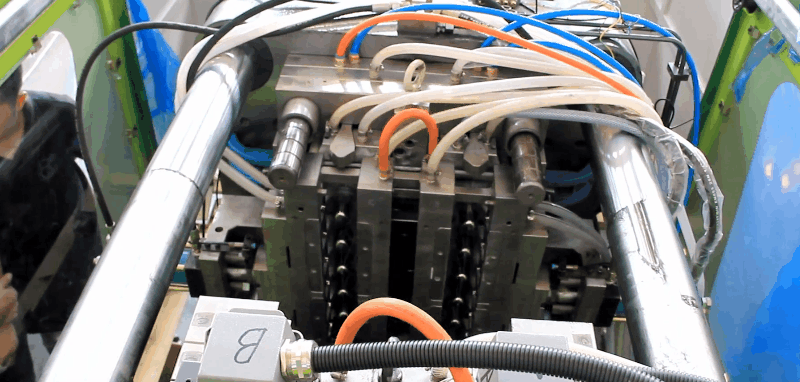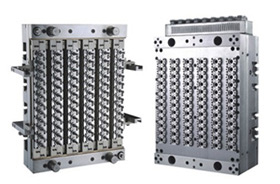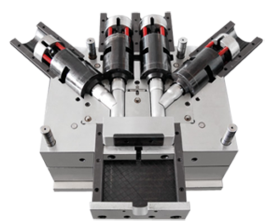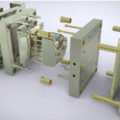How to Check the Barrel and Ring Wearing of Injection Molding Machine The following phenomenon may possibly be encountered depending on the type of resin used in operation for a long period of time. (1) The cushion amount fluctuates. (2) Sink marks cannot be eliminated. (3) The absolute value of the cushion amount becomes lessened. In this case, the barrel or check ring may have been worn. To inspect the wearing state of the barrel or check ring, it is preferable to actually measure the sizes of the barrel or check ring. In the actual case, however, checking by means of double shots is available to simply judge the wearing of the barrel or check ring as described below. * Double shot is to conduct injection again without mold opening or product take-out after injecting charged melt into the mold cavity. The screw advances little even if double shots are carried out. The screw keeps advancing when double shots are carried out. [Recommended conditions] Holding time (TRH1) = 5 s Injection time = 5 s Holding pressure (PH1) = 100
Read more →Heater Maintenance and Inspection of Injection Molding Machines Band heaters or aluminum-cast heaters are usually used for the barrel. Most of our injection molding machines use the former, band heaters in which Nichrome wire is placed between stainless sheets and insulated with mica. Follow the procedure below for the maintenance and inspection of the heaters. 1) Heater band failure is mainly caused by improper tightening. The watt density of heater is about 3 ~ 5 W/cm2. A less contacting area with the barrel results in self-heating and eventually in disconnection. Thus retighten heaters while hot at least once a month. 2) When retightening the above, also inspect screws of heater wiring (such as screws for the terminal box, contactors, etc.) for looseness. 3) Heaters should show a few megaohms or more of insulation resistance after being heated once. Insulation resistance of less than one megaohm (1MΩ) will adversely affect the human body due to leak current. Investigate the cause of the problem and replace heaters if no cause is found. 4) When retightening the above, also inspect thermocouples for secure
Read more →Forced Grease Mode in Injection Molding Machines The forced grease mode function is to exhaust air when the air entering in a grease line is observed even after air venting work at grease cartridge replacement (the injection machine does not move smoothly or grease cannot reach each greasing point) or to change grease inside the grease line after a long downtime of the injection machine. Execution of forced greasing effectively prevents damages on ball screws, link pins or linear guides, or motor load increasing. (1) Operation The greasing pump operates by forced grease mode and supplies grease to each valve. After the pump pressure reaches to 5MPa (725psi), the greasing pump outputs pump stop signal and stop operation. Then each valve discharges grease to greasing points and the pump starts operation again after one minute. The pump repeats that procedure five times. (Repeat number setting: C106) (2) Performance circuit diagram The performance circuit diagram of forced greasing is as follows. Operation procedure of forced grease mode: 1) Press [SERVO] of the PREPARATION button on the operation controller to turn off
Read more →How to Replace the Grease Cartridge in Injection Molding Machines When grease is getting short in the grease cartridge or an alarming comment [GREASE IS SHORT] is activated, replace the grease cartridge by following the procedure below. FS-2 (by LUBE) that is for former greasing pump can not be used for P-107 because of differences in pump discharge pressure and grease consistency. FS-2, if used, may cause pump breakage or pipe clogging. [New pump] Model: P-107 (discharge pressure: 5 MPa) Recommended grease: LHL-X100 (*FS-2 can not be used.) [Former pump] Model: EGM-10T(MP)-4-7C (discharge pressure: 10 MPa) Recommended grease: FS-2 or LHL-X100 (* LHL-X100 can be used for new pump and former pump.) 1) Turn counterclockwise and remove the clear cover from the pump. 2) Turn counterclockwise and remove the empty cartridge from the pump. 3) Insert new cartridge to the pump together with the inside plug, and turn clockwise and set to the pump. Exercise care not to enter air or foreign matter into the inside. (The inside plug gets torn when new cartridge is inserted to the pump.) 4)
Read more →Mold Mounting and Die Height Adjustment on Injection Molding Machines [1] Press [SET-UP] of the OPERATION selector button on the operation controller. [2] Mold opening Continuously press [OPEN] of the MOLD button on the operation controller to open the movable platen to the open limit. NOTE: If mold entry is difficult even after the movable platen opened to the open limit, press [OPEN] of the DIE HEIGHT button to open the mold platen to the position to allow mold entry. [3] Nozzle retract Press [RETRACT] of the NOZZLE button on the operation controller to move the nozzle to the retract limit. [4] Press [SERVO] of the PREPARATION button on the operation controller to turn off the servomotor. [5] Mold lifting and positioning Lift the mold with both movable and stationary mold halves coupled and insert the mold locating ring into the locating ring hole of the stationary platen for positioning. * For Min. mold height / Max. mold height / Min. mold size, refer to the instruction manual “APPENDIX”. [6] Press [SERVO] of the PREPARATION button on the operation controller
Read more →Replacement of Ejecting Rods on Injection Molding Machines [1] Press [SET-UP] of the OPERATION selector button to close the safety gate. [2] Mold opening Press [OPEN] of the MOLD button on the operation controller to open the mold. [3] Setting of ejection mode and count 1) Change the INJECTVISOR screen to [CLAMP]. 2) Press the [CLAMP] screen selector button and the [CLAMP] screen change button to display the [CLAMP] screen. 3) Touch [A] of [EJECT MODE] on the [CLAMP] screen to select ejection mode [A]. 4) Touch [EJC COUNT] switch on the [CLAMP] screen to open the [EJC COUNTS] window. 5) Touch the necessary count for ejection on the window. 6) Touch [x] (close) to close the window. [4] Setting of ejection and ejector retraction speeds By using the same screen, set ejection speeds [VE1], [VE2] and ejector retraction speeds [VR] in the range of 50 ~ 100 mm/s [2 ~ 4 in/s]. 1) Touch [VE1] on the screen, to open the [VE1 EJECT ADVANCE SPEED1] window. 2) Set ejection speed [VE1] on the step switch of the setting window.
Read more →Mold Set-up Guides on Toshiba Injection Molding Machines Mold Set-up Preparation Check if the mold matches the injection molding machine. [1] Check if mold sizes matches the injection molding machine. Mold width H < Distance between tie rods, or Mold height, V < Distance between tie rods * Refer to the specifications for the Distance between tie rods H / Max. mold height / Min. mold height. [2] Injection volume check [3] Check for mold locating ring and locating ring hole of stationary platen. * The locating ring hole diameter may be changed according to the machine specification. Refer to the attached drawing, MOLD MOUNTING SPACE for checking. [4] Check for sprue bushing and nozzle [5] Nozzle touch check H < Nozzle projection amount [message type="custom"] [one_half] * Projection amount of the standard nozzle i0.4 unit: 30 mm [1.18in] i1 and i1.5 units: 20 mm [0.79in] i2Y unit: 30 mm [1.18in] i2A and larger units: 65 mm [2.56in] [/one_half] [one_half_last] * Check if the clearances of nozzle heater and thermocouple to sprue bushing hole are secured. [/one_half_last] [/message] [6] Clamping
Read more →Clamp Unit`s Mechanical Configuration and Movement on Toshiba All-electric Injection Molding Makers [1] Mold open / close AC servomotor and toggle link mechanisms are installed to open and close the mold. ・ Operation principle The ball screw fixed to the movable platen is driven by the servo motor to open and close the movable platen. ・ Stroke range The stroke range of the movable platen is fixed by the controller setting. [2] Ejector ・ Operation principle The ball screw fixed to the ejector plate is driven by the servomotor to advance or retract the ejecting rods. ・ Stroke range The stroke range of the ejecting rod advance/retract is fixed by the controller setting. [3] Link housing advance/retract (die height adjustment) ・ Operation principle The toggle type mold clamp unit requires adjusting the link mechanism position according to the mold thickness to be used. Four pieces of tie rod nuts fixed to the link housing are driven by the geared motor by way of gears to adjust the mold thickness. ・ Stroke range Proximity switches are installed on both the advance
Read more →Injection Unit`s Mechanical Configuration and Movement [1] Screw advance/retract ・ Operation principle The AC servomotor for injection turns the ball screw nut and moves the ball screw back and forth to advance or retract the screw. ・ Stroke range The stroke range of screw advance/retract is fixed by the controller setting. [2] Charge (screw running) ・ Operation principle Rotation of the AC servomotor for charging (screw running) is transmitted to the screw by way of a timing belt. ・ Stroke range The stroke range of charging (screw running) is not on the controller setting. [3] Injection unit advance/retract (nozzle touch) ・ Operation principle The injection unit advances or retracts being driven by a geared motor by way of the ball screw. The brake holds nozzle touch force. Hence the geared motor rotates only when required and consumes no excessive energy. ・ Stroke range Limit switches are installed on both the advance and retract limits of the injection unit to determine stroke range. On reaching the limit, the injection unit stops advancing or retracting.
Read more →Clamping System of Injection Molding Machines In order to keep the mould halves tightly closed when the melt is being injected under high pressure it is necessary to have a clamping system. Most common type of clamping systems are: 1. Hydraulic 2. Mechanical In the hydraulic systems, oil under pressure is introduced behind a piston connected to the moving platen of the machine. This causes the mould to close and the clamp force can be adjusted so that there is no leakage of molten plastic from the mould. In the mechanical system, the toggle is the mechanical device used to amplify the force. Toggle mechanisms tend to be preferred for high speed machines and where the clamping force is relatively small. The main advantages of the toggle system are that it is more economical to run the small hydraulic cylinder and since the toggle is self locking it is not necessary to maintain the hydraulic pressure throughout the moulding cycle. The disadvantages of the system is that there is no indication of the clamping force and the additional moving parts
Read more →Mold Temperature Control in Plastic Injection Molds If we want to get efficient moulding, we should control the mould temperature and this is done by means of passing fluid through a suitable arrangement of channel in the mould. The rate at which the moulding cools affect the total cycle time as well as the surface finish, tolerances, distortion and internal stresses of the moulded article. High mould temperature improves the surface gloss and tend to eliminate voids. If the mould temperature is too low then the material may freeze in the cavity before it is filled.
Read more →How to Inspect Lubrication System of Injection Molding Machines Inspect the lubrication status of the respective unit for the following points. (1) Check if lubrication is insufficient. (2) Check if grease is discolored, fouled or solidified. (3) Check if refuse or foreign matter is caught. (4) Check the sliding surface for scratches. When grease on the ball screw is fouled or catching foreign matter, wipe off the grease with a piece of clean cloth. Never use a solvent for this purpose. Using a solvent cuts oil film while possibly shortening ball screw life. When the mold has not been changed for a long time, press OPEN and CLOSE of the DIE HEIGHT button to open and close the platen one time for the purpose of lubricating the mold thickness setter. At this time move the platen for the full stroke of DIE HEIGHT. The following portions are equipped with automatic greasing circuits. Be sure to use high load-resistant high-performance grease recommended by us for the automatic greasing circuit. 1) Injection ball screw 2) Injection linear guide 3) Ball screw for
Read more →






